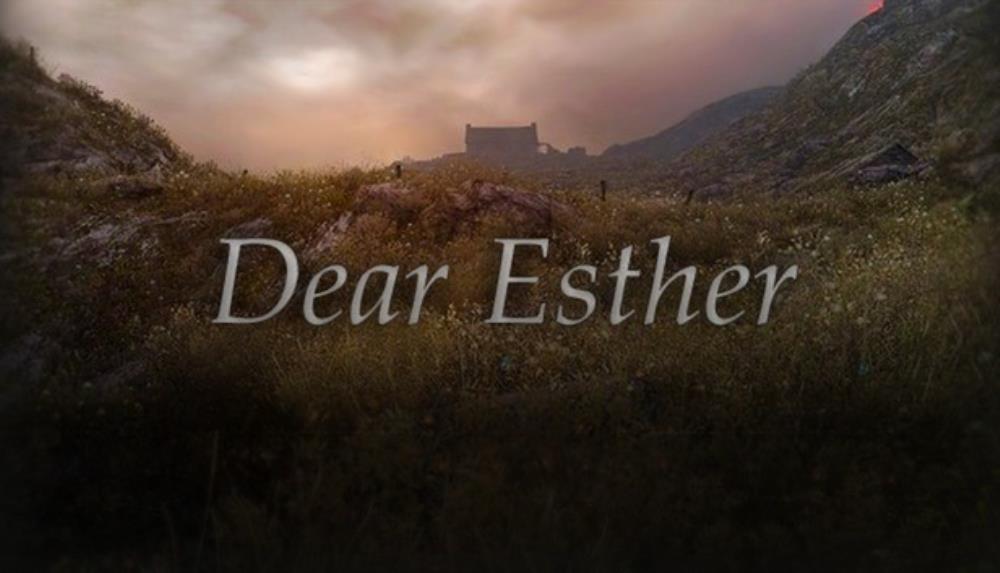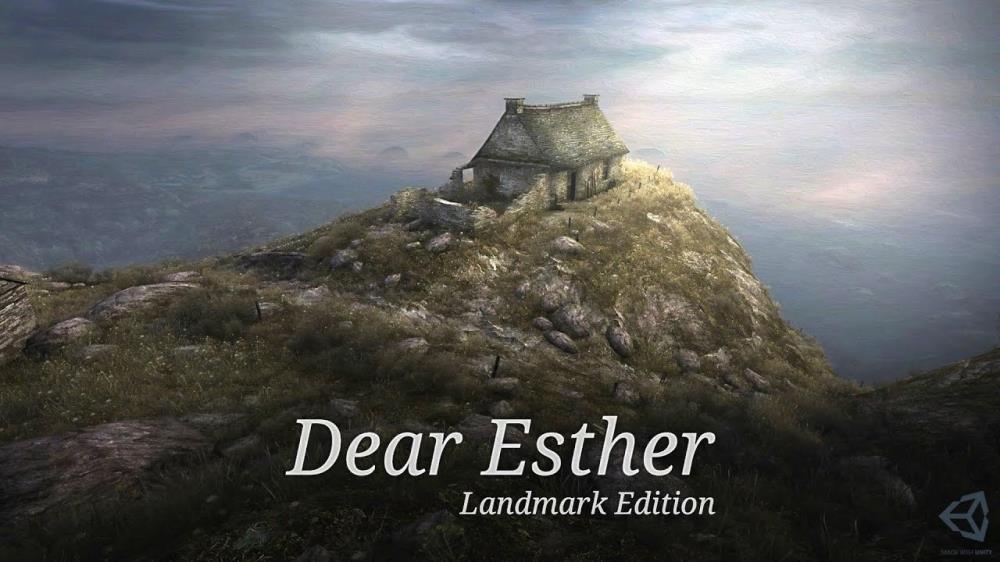Independent game studio The Chinese Room has been better known for their Half Life 2 mods. First released in June 2008 as a free mod for the Source engine, Dear Esther was completely remade from 2009 to 2011 for a commercial release in 2012 with a ten dollar price tag. Unwilling to bow down to conventional game wisdom, Dear Esther is a game that focuses more on stimulating the player through storytelling rather than gameplay mechanics-an ambitious attempt in today’s market. While there’s much praise to be given in what it’s trying to attempt, there’s little admiration in the way of what the game has actually accomplished.
The game starts off displaying its epistolary narrative as this-supposedly-shipwrecked person gives his monologue to Esther. Only a few feet away from the starting point is a run-down cabin and lighthouse that looked to have been abandoned for years. From here, your investigation of this unnamed Hebridean island truly begins taking a turn for the stranger.
In regards to quality, this enigmatic story is one of the most erratic and engaging to be played in recent history. During the long hike to the end, many of the “Dear Esther…” monologues given (with different variants if you replay those sections) throughout the adventure evoke a sense of an awesome tragedy that’s rife with interesting symbolism-although biblical references feel clumsy. For every thought-provoking narration, there’s always a tawdry line or two that sticks out like a sore thumb, most noticeably when the narrator starts comparing body parts to the island. While these tasteless lines jut out every now and then, the story is oftentimes delivered in eloquently stated sentences that will stick with the player. The consistency is rather disheartening, but the great moments will more than likely be remembered.
The visuals are some of the best to be seen in an indie title. The amount of extra detail in the final product compared to the mod when it first released is astounding. From the draw distance of steep cliff heads to refulgent caves glimmering from the slightest hint of light, there’s always some artistic detail to appreciate from beginning to end. The technical requirements for the game are pretty low as well. Even though I played on a laptop and lowered the settings, it wasn’t hard for me to be left in awe at certain points, which was helped by a smooth frame rate-then again, walking and stopping are your only movement options. Overall, Dear Esther is worthy of winning visual design awards; it’s still technically limited to the aging engine being used, but that makes certain details all the more impressive.
The sound design in both voice acting and musical score are what truly shine. Despite being the only voice you’ll hear, Nigel Carrington’s excellent British timbre made every read letter to Esther a treat to hear. Even more interesting is the dedication given to the delivery of each line, even when the words would fall flat. Starting out as a more stolid narrator, his emotions began to grow more and more as we neared the finish line. As he became more acrimonious of the situation, I too would become more bitter about this island. Supporting these moments is a well-rounded track that contains a variety of stringed instruments and piano keys. Specific moments of discovery in Dear Esther become unforgettable thanks to these excellently-paced scores. While it’s a shame that the sound of soft footsteps are essentially filler until the next invisible line is crossed to start the next narration or score, the sound design still stands as the best quality to be found in this title.
The gameplay, or lack thereof, in Dear Esther is the weakest aspect of the game. You’re limited to only a few buttons: the W, A, S, and D keys are for movement, Q key to swim up, and left-click on the mouse allows you to zoom in. Even from this reduced control scheme, the forward, right, and left movements can still get you through the game, since there’s no oxygen meter for the underwater sections. What this amounts to is an overwhelming feeling of a game controlling too much of what you’re allowed to do (even crouching is done automatically). While the idea of limiting the player’s fastest speed to a casual walk and turning the flashlight on naturally in dark areas does make sense from a pacing perspective, it also feels like a way to hide the fact that this adventure could be finished in a half-hour if it had a normal control scheme (average run-time will be around one and one-half to two hours).
While it may seem strange to lynch-pin storytelling to where I focus on gameplay, this is one of those rare cases where it makes sense. Dear Esther is reminiscent of the “Iceberg Theory” (found most popularly in Hemingway’s works) in regards to both narrative and gameplay. Similar to an iceberg, the twenty percent all gamers see (the control scheme) is there and restricted, while the other eighty percent (emotional exploration through storytelling) is-theoretically-meant to be deciphered by the gamer’s experience. Conceptually, this idea does make sense; however, Dear Esther’s scant monologue given to those who purposefully go off course harms what seems to be a brilliant idea. Even after wanting to get lost to hear more narrative, I was rarely rewarded for my searches. There are so many times presented for the player to either examine work and discover something, yet is treated with nothing but what’s presented to them. Even light green words etched across cliff walls don’t present anything that gives a better direction to this vague story. After becoming lost so often with little reward for it (one time I received just a simple sentence for intentionally taking a wrong route), it came with great disappointment to realize Dear Esther’s overall gameplay is downright obstructing, both above and below the surface.
While Dear Esther does feel utterly lacking in some regards, I still believe these types of “games” do have a place in this medium. You can have great story-driven games with limited control schemes, but not to the point of feeling bare-boned. For all the criticism given to “hand-holding” games, I don’t see why heuristic titles that offer no reward in discovery shouldn't receive the same amount of ire from gamers; in fact, it’s kind of nice to know I’m not going to be fooled with those other popular titles (which shall remain nameless) into believing there is something tangible between point A and point B. I can appreciate the themes presented in a poetic manner throughout the story, though roadblocks make it feel pretentious at times, and the excellent visual/audio design, but it comes at such a detrimental cost. In the end, Dear Esther presents an educated challenge on what to expect in a game, yet stumbles on the most elementary methods.
coolbeans' *RotteN* badge

The Chinese Room's Dear Esther goes free on Steam to celebrate the 10th anniversary of this foundational title.
Eh.
I mean free is free, but I found this to be a boring slog.
Not to mention this remasters actually made the game look worse in multiple areas.
I did quite like their A Machine for Pigs and Everybody's Gone to the Rapture though.

On Valentine's Day a decade ago, Dear Esther went from a Source Engine mod to a full-fledged indie game, catalyzing the "walking sim" genre. How does it measure up today?
"The China-based indie games publisher Secret Mode and Brighton-based (the UK) indie games developer The Chinese Room, are today very pleased to announce that they will celebrate the tenth anniversary of "Dear Esther" by making the genre-defining 2012 narrative exploration game free to download from February 14th to February 15th via Steam." - Jonas Ek, TGG.
Hope everyone enjoyed the review. :D
It's rather surprising to see how tough it was to review a game that's based so much around experiences. It was a fun criticism, but felt like a chore to explain sometimes.
http://www.escapistmagazine...
Even though I watched this BEFORE purchasing the title, I can now see that the likes of other games I was eyeing like 'The Path' are probably not for me (save if it's free). I recommend watching the Jimquisition video linked and reading RobotGeeker's solid 9.0 review (on this site) so you get a better idea of where your allegiances lie. It seems to be one of those divisive games that you'll either love or hate.
I have kind of same opinion, but for me its not much of the game, its more like program. I bought it and I feel like that money goes intothis product, was horribly wasted. I don't even got some emotional connection, its was just bad. I guess, that these days you can do something different and you will be priced by many people, just to be different, despite the fact that you "game" sucks. I don't want to be a hater, because we need more different experiences, but not in this way.
Good review, but I can't help but notice that it's a review from someone who doesn't really understand the vision and basis behind the game. It's not meant to have some sort of extensive or in-depth gameplay, hence the simplistic control scheme. The game is meant to tell a story, and while I can understand the overall disappointment that one might have after purchasing it and realizing it's not much of a game but a story-telling, that's why one ought to research the game first. ;)
The game left me thinking after I finished it, and for quite a while after I still felt a little depressed thinking about it. Whenever we view, play or listen to any kind of media it should make us feel a certain emotion, and for me the game really delivered in what it set out to do.
It's not for everyone, I particularly enjoyed it because I feel it explores the idea of video games being a medium for a more narrative story, there's definitely a disconnection between traditional games, which is both an accomplishment and maybe a failure.